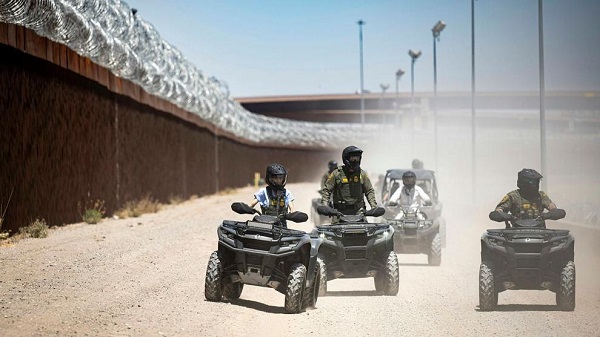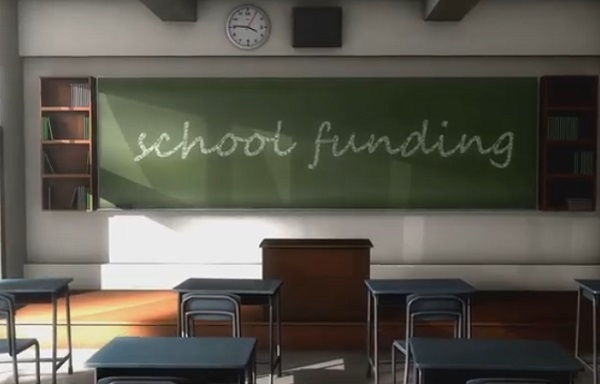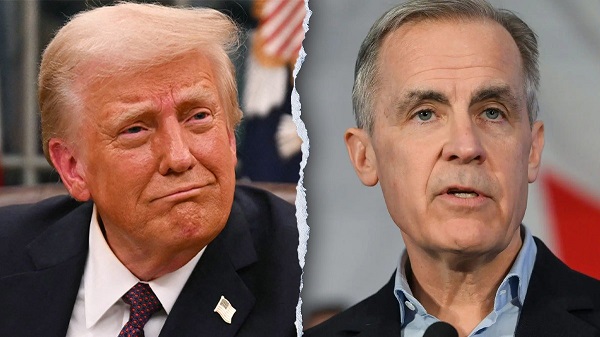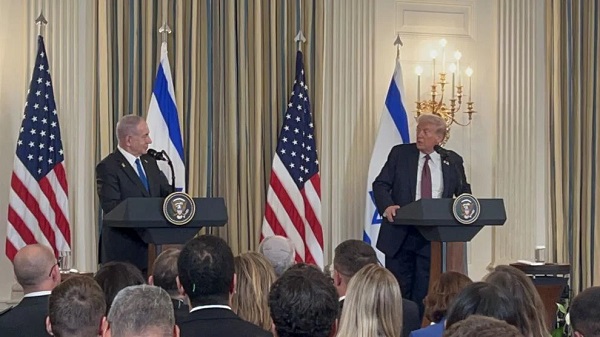International
Hamas releases all living hostages under Trump peace plan

Quick Hit:
All 20 surviving Israeli hostages were freed by Hamas on Monday under President Trump’s peace plan, returning to Israel after more than two years in captivity. The exchange, part of Trump’s 20-point peace plan, marks the official end of the Gaza war.
Key Details:
- The first seven hostages were released around 2:30 a.m. ET Monday, with the remaining 13 freed hours later. All 20 were reportedly able to walk to Red Cross vehicles without assistance.
- Families were reunited through emotional video calls after 738 days apart. Among those freed were twin brothers Gali and Ziv Berman, who had been separated in captivity.
- The bodies of 28 deceased hostages are expected to be transferred to Israel in the coming days, while nearly 2,000 Palestinian prisoners will be released as part of the exchange.
Watch the moments that Rom Broslavski, Nimrod Cohen, and Eitan Horn were welcomed back home into Israel by the IDF 🇮🇱 pic.twitter.com/panFrDZfoI
— Israel Defense Forces (@IDF) October 13, 2025
Tears of joy. pic.twitter.com/vb7tGZqAY9
— Israel Defense Forces (@IDF) October 13, 2025
Diving Deeper:
All surviving Israeli hostages held by Hamas in Gaza were released Monday following the implementation of President Donald Trump’s cease-fire agreement — a sweeping deal that has brought an end to the war and set in motion plans for Hamas’ disarmament.
The International Committee of the Red Cross oversaw the transfer of all 20 living hostages, who emerged from Gaza under their own power and were handed over to Israeli forces before being transported to hospitals for medical evaluation. Emotional scenes followed as families connected with their loved ones for the first time in more than two years. In one particularly poignant moment, twin brothers Gali and Ziv Berman — who had been held separately since October 2023 — embraced in a tearful reunion.
The exchange also includes the return of 28 bodies still held by Hamas. Their repatriation will take place in stages throughout the week, according to Israeli officials. The release fulfills a major milestone in Trump’s 20-point Gaza peace plan, which was brokered with the support of Egypt, Qatar, and Jordan. The agreement requires Hamas to surrender its remaining weapons, disband its militant wings, and cede control of Gaza to an international transitional authority.
The hostage crisis began during the October 7, 2023, terror attacks on southern Israel, when Hamas militants stormed across the border, kidnapping more than 250 civilians. Survivors of earlier exchanges described brutal conditions in captivity, including torture, starvation, and psychological abuse. Some hostages were executed when Israeli troops approached Hamas strongholds, including six victims shot at point-blank range last September.
The war left much of Gaza in ruins, with Israeli operations dismantling Hamas’s tunnel networks and command infrastructure. According to the Hamas-run Gaza Health Ministry, more than 67,000 Palestinians were killed — a figure that does not distinguish between militants and civilians.
Trump’s cease-fire framework, announced last week, called for a complete Israeli withdrawal from most of Gaza, an end to rocket fire, and an international effort to oversee the territory’s reconstruction. In return, Israel secured the unconditional release of all living hostages and the recovery of the dead. The plan’s next phase will focus on humanitarian coordination, economic stabilization, and the eventual formation of a demilitarized Palestinian administration.
For the families of those held captive, it marks the end of a long nightmare — and, as many said Monday, the start of long-awaited healing.
Business
Truckers see pay surge as ICE sweeps illegal drivers off U.S. highways

Quick Hit:
American truckers say they’re finally earning more per mile as President Donald Trump’s enforcement push clears illegal drivers off U.S. highways. Truckers have reported 50% pay increases on some routes following a surge of ICE activity and Transportation Secretary Sean Duffy’s crackdown on safety and work permit violations.
Key Details:
- A trucker on X said his usual Chicago-to-Fargo run jumped from $1,200 to $1,800, crediting the Trump administration’s immigration enforcement for thinning out illegal competitors.
- ICE and federal transportation officials have detained or removed illegal drivers in multiple states, with reports of Serbian and Indian drivers losing their commercial licenses after failing to prove legal entry into the U.S.
- FreightWaves founder Craig Fuller noted spot rates have risen about 2% despite weak demand, as “bottom feeders” who undercut prices are being “squeezed out of the market.”
Diving Deeper:
As President Trump’s immigration enforcement intensifies, American truckers are seeing something rare in a sluggish cargo economy: rising wages. Across online freight boards and social media, truckers are crediting the administration’s “Compliance Crunch” — a combination of ICE raids and new safety regulations — for clearing out illegal drivers who had been depressing pay rates for years.
One trucker wrote on X that his typical Chicago-to-Fargo route, which paid $1,200 before the election, now brings in $1,800. “Needless to say, I took him up on the offer,” he posted. “Lord do I hope this hangs around a little bit.”
Transportation Secretary Sean Duffy has been enforcing long-ignored safety and documentation rules, targeting companies that hired drivers without valid immigration status or complete customs paperwork. “We have Americans who’ve been in trucking for 50 years through family businesses,” Duffy told Fox News on October 8. “They can’t do business anymore because you have these illegals coming in, living out of their trucks… they can’t speak the language, and they come in under price — way under price.”
According to reports from The Serbian Times, at least fifteen Serbian drivers have been detained in recent days, and agents have begun seizing commercial driver’s licenses from migrants lacking proof of legal entry. Many of these drivers, primarily from Eastern Europe and South Asia, were able to operate under the Biden administration with minimal oversight — often undercutting legitimate American drivers by accepting lower pay.
Craig Fuller of FreightWaves observed that even though freight volumes remain “anemic,” per-mile spot rates rose roughly 2% as noncompliant firms exit the market. “We are seeing the bottom feeders get squeezed out,” he wrote, adding that most contract carriers haven’t yet felt the wage impact but likely will as enforcement spreads.
Industry experts say nearly one-third of the nation’s freight has been hauled by non-citizen drivers, which trucking analyst Bill Skinner called “not just a safety issue — it’s a national security risk.”
While some corporate logistics networks such as Amazon and Walmart may eventually argue that higher trucking wages could drive up costs, analysts note that the increases are modest and likely offset by fewer accidents, delays, and fraud cases tied to unlicensed or illegal operators.
illegal immigration
$4.5B awarded in new contracts to build Smart Wall along southwest border

Homeland Security Secretary Kristi Noem rides an ATV along the U.S.-Mexico border wall in El Paso, Texas, on April 28, 2025. Photo: Tia Dufour / U.S. Department of Homeland Security
From The Center Square
By
New contracts to add 230 miles of barriers, nearly 400 miles of technology
Roughly $4.5 billion in contracts have been awarded to expand border wall construction, including adding advanced technological surveillance along the southwest border.
Ten new construction contracts have been awarded through the U.S. Department of Homeland Security and U.S. Customs and Border Protection to add hundreds of miles of Smart Wall in California, Arizona, New Mexico and Texas.
“For years, Washington talked about border security but failed to deliver. This President changed that,” CBP Commissioner Rodney Scott said. “The Smart Wall means more miles of barriers, more technology, and more capability for our agents on the ground. This is how you take control of the border.”

Scott has championed advancing a Smart Wall border security system for years. A border security system is far more than a wall, he has told The Center Square, it’s an ecosystem.
The system encompasses steel and waterborne barriers, patrol roads, lights, cameras, advanced detection technology, including towers and aerostats, to provide Border Patrol agents with a range of tools to detect and interdict illegal activity.
CBP has published an interactive map to educate the public about the Smart Wall system. The map highlights areas of the 1,954-mile U.S.-Mexico border where wall construction has been completed, where border wall panels or waterborne barriers are under construction, where contracts have been awarded for proposed projects in the design phase or early construction, and planned construction areas that haven’t yet been awarded contracts.
Prior to Jan. 20, 2025, 702 miles of existing barriers had been constructed of primary wall and 76 miles of secondary wall, according to CBP data.
The new plan includes implementing barrier technology along 532 miles of the border where no barrier exists because of unfavorable terrain or remote location. It also includes deploying 550 miles of technology throughout previously constructed barriers, CBP says. Specific areas are also being built out in regions where contracts were previously canceled by the Biden administration.
In California, $483.5 million in taxpayer funding was awarded to BCCG Joint Venture for the Diego 1 Project to construct nine miles of new Smart Wall and 52 miles of system attributes in the San Diego Sector.
An additional $574 million was awarded to Fisher Sand & Gravel Co. for the El Centro 1 Project to construct eight miles of Smart Wall and install 63 miles of system attributes in the San Diego and El Centro sectors.
In California and Arizona, $199.5 million was awarded to Barnard Spencer Joint Venture for the Yuma 1 Project to construct 60 miles of system attributes in the Yuma Sector.
In Arizona, nearly $607 million was awarded to BCCG for the Tucson 1 Project to construct 23 miles of new secondary border wall and 66 miles of system attributes in the Tucson and Yuma sectors.
In New Mexico, $155.1 million was awarded to BCCG for the El Paso 1 Project to replace seven miles of old dilapidated barrier fencing in the Santa Teresa Area of Responsibility with a new Smart Wall. BCCG will also complete 22 miles of system attributes in the El Paso Sector in New Mexico.
Also in the El Paso Sector in New Mexico, Barnard Spencer Joint Venture was awarded nearly $579 million for the El Paso 2 Project to construct 23 miles of new Smart Wall and 81 miles of system attributes.
In the El Paso Sector in far west Texas, BCCG Joint Venture was awarded $850.4 million for the El Paso 3 Project to construct 42 miles of new primary Smart Wall, six miles of new secondary border wall and 46 miles of system attributes.
In Texas, BCCG Joint Venture was awarded $565 million for the Del Rio 1 Project to construct 22 miles of new primary Smart Wall, replace two miles of old barrier wall, and deploy 40 miles of waterborne barrier system in the Eagle Pass Area of Responsibility in the Del Rio Sector.
BCCG was also awarded $364.3 million for the Del Rio 2 Project to construct 10 miles of new primary Smart Wall, 23 miles of waterborne barrier system, and install 10 miles of system attributes in Eagle Pass.
BCCG was also awarded $96.1 million for the Rio Grande Valley Waterborne Barrier Project to deploy 17 miles of waterborne barrier in the Rio Grande River, south of Brownsville in Cameron County in the Rio Grande Valley Sector.
Another $550 million worth of contracts was also awarded to support Smart Wall construction. Additional construction and contracts are expected.
Funding for the projects comes from the “One Big Beautiful Bill,” which President Donald Trump signed into law. It also includes some fiscal year 2021 border wall appropriations that were frozen during the Biden administration.
Waivers were also issued by DHS Secretary Kristi Noem to expedite construction of nine miles in the San Diego Sector and 30 miles in the El Paso Sector in New Mexico. Both sectors were inundated with record high illegal traffic during the Biden administration.
-

 Frontier Centre for Public Policy1 day ago
Frontier Centre for Public Policy1 day agoCanada’s Democracy Is Running On Fumes
-

 Media1 day ago
Media1 day agoResponse to any budget sleight of hand will determine which audience media have decided to serve
-

 Education1 day ago
Education1 day agoClassroom Size Isn’t The Real Issue
-

 International19 hours ago
International19 hours agoMelania Trump quietly reunites children divided by Ukraine war
-

 Business1 day ago
Business1 day agoYour $350 Grocery Question: Gouging or Economics?
-

 illegal immigration19 hours ago
illegal immigration19 hours ago$4.5B awarded in new contracts to build Smart Wall along southwest border
-

 Brownstone Institute2 hours ago
Brownstone Institute2 hours agoTrump Covets the Nobel Peace Prize
-

 COVID-199 hours ago
COVID-199 hours agoThe Trials of Liberty: What the Truckers Taught Canada About Power and Protest






